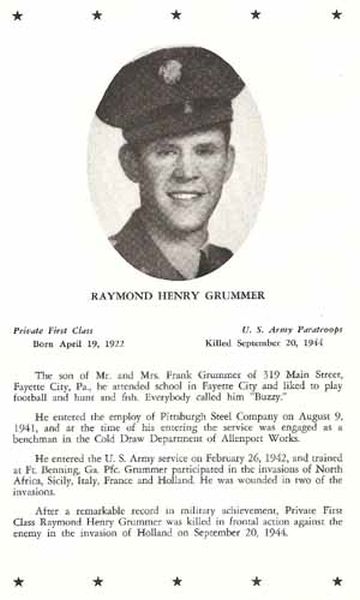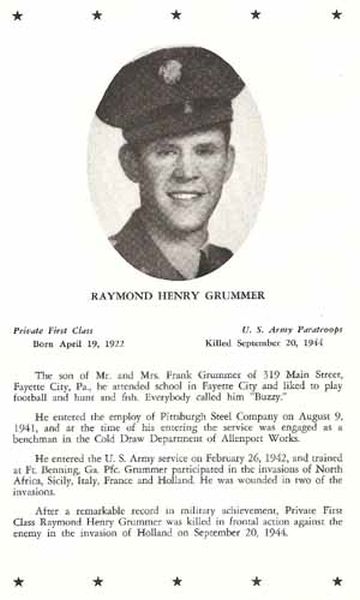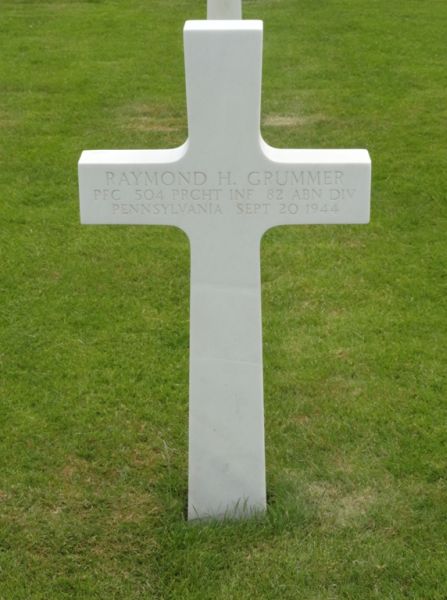Grummer, Raymond Henry
- Date of birth:
- April 19th, 1922 (Fayette City/Pennsylvania, United States)
- Date of death:
- September 20th, 1944 (near Nijmegen, the Netherlands)
- Buried on:
- Netherlands American Cemetery and Memorial
Plot: M. Row: 11. Grave: 1. - Service number:
- 13 058 477
- Nationality:
- American
Biography
Private First Class (PFC) Raymond Henry Grummer, nicknamed as “Ray” and “Buzzy”, was born on April 19, 1922, in Charleroi, Washington County, Pennsylvania, the United States of America. Ray was the son of Frank C. Grummer and Anna B. Burgan and had a younger sister, Ethel. After grammar school Ray went to Fayette City High School where he graduated in 1941. Then he went to work at the Pittsburgh Steel Company in Allenport.
On February 25, 1942, Ray volunteered and enlisted in the US Army, in Pittsburgh, Pennsylvania. He received his training in Fort Benning, Georgia, and in the Fall of the same year he was assigned to I Company, 3rd Battalion, 504th Parachute Infantry Regiment (504 PIR), 82nd Airborne Division “All American”. In April 1943, 504 PIR was shipped to North-Africa and Ray started preparing with his unit for his first combat jump.
In July 1943 he made his first parachute jump above enemy territory, during operation Husky, on Sicily. In September 1943, Ray’s second combat action followed, when he participated in the amphibious landing near Salerno with his unit, during operation Avalanche. His regiment (504 PIR), was thereafter assigned to lead the 5th US Army as mountain infantry in its push from Naples towards Rome. At the same time, the rest of the 82nd Airborne Division left Italy for England. During the push towards Rome, Ray got injured under combat conditions in December receiving grenade shrapnel in his shoulder and back. After a short hospital admission and treatment he was sent back to his unit. He was rewarded with his first Purple Heart for those injuries. In January 1944, Ray participated in the operation Shingle, the amphibious landing at Anzio. There again, Ray got wounded during combat, on February 8. He received his first Oak Leaf Cluster (OLC) for his Purple Heart medal. After his recovery in a hospital in Naples, Ray was named “Buzzy” by his buddies when he returned to his unit. 504 PIR was pulled from the front in end of March and then shipped to England in April 1944. There the regiment returned back to the fold of the 82nd Airborne Division. 504 PIR had suffered too many personnel losses that couldn’t get replaced in time, and hence the regiment didn’t participate in Operation Overlord, D-Day, in June 1944. The regiment had to stay in England and recuperate and train for the future combat. Ray, who was promoted to Private First Class, prepared with his buddies from I Company, for their next operation, Market Garden.
On September 17th, 1944, Ray jumped above the Netherlands, with his unit, near Overasselt. 504 PIR’s objectives were to immediately capture the bridges across the river Maas and the Maas-Waal canal. The 3rd Battalion, with Ray, had to secure the western flank of the regiment, while the 2nd Battalion had to take the Maas-bridge near Grave and the 1st Battalion had to capture the bridges crossing the Maas-Waal canal. The regiment succeeded within 24 hours after the paradropping. In the afternoon of September 19, the 3rd Battalion became division-reserve of the 82nd Airborne Division. Ray, together with his fellow troopers of the 3rd Battalion, marched via bridge number 7 (near Heumen), to the southern suburbs of Nijmegen. That night they camped in the Jonkerbosch woods. That same evening, the commanding officer (CO) of the 3rd Battalion, Major Julian Aaron Cook, received the order of General Gavin, CO of the 82nd Airborne Division, to cross the river Waal the next day by boat. The battalion had to seize the northern approaches and ramps of the two bridges crossing the Waal near Nijmegen.
Together with his fellow warriors of the 3rd Battalion, Ray marched, on the morning of September 20, to the south bank of the river Waal near the Nijmegen powerplant at the NYMA area. There they had to wait for the arrival of the canvas boats that had to be transported all the way from a Belgium depot to Nijmegen. Ray’s unit, the I Company, together with the battalion staff and H Company, would cross the Waal in the first wave.
On September 20, 1944, Tony probably was assigned to the same boat as PVTs Anthony Bei, Leonard G. Trimble, Dale E. Campbell and Jack M. Seitzinger. At 15.00 the assault kicked off with a preliminary bombardment and at 15.15 the men moved, while carrying their boats and gear, to the Waal and then started to row across the river. The boats were almost immediately spotted by the enemy and were heavily shot at with mortar fire, machine guns (MG) and antiair artillery (FLAK). At what point exactly Ray’s boat was hit by enemy fire remains unclear, but only Trimble was to survive their ordeal. The boat reportedly circled and drifted back to the south bank of the river, where the severely wounded Trimble was picked up and brought to the nearest first-aid station. Next to Ray, also Bei, Campbell and Seitzinger were killed.
PFC Raymond Henry Grummer was 22 years of age, when he got killed in action on the river Waal near Nijmegen on the afternoon of September 20, 1944. At first he was buried at the temporary graveyard in Molenhoek, south of Nijmegen. Later he was reburied at the Netherlands American Cemetery in Margraten, the Netherlands; in plot M, row 11, grave 1.
Do you have more information about this person? Inform us!
- Period:
- Second World War (1939-1945)
- Awarded for:
- Operation Husky
First Purple Heart awarded for his injuries while in combat on Sicily
- Period:
- Second World War (1939-1945)
- Awarded for:
- Operation Shingle
Second Purple Heart awarded in the form of a bronze oak laef cluster to be placed on the ribbon of the first Purple Heart for his injuries received on February 8th, 1944, near Anzio.
- Period:
- Second World War (1939-1945)
- Rank:
- Private 1st Class
- Unit:
- Company I, 3rd Battalion, 504th Parachute Infantry Regiment, 82nd Airborne Division "All American", U.S. Army
- Awarded for:
- Operation Market Garden
Awarded posthumously.
Third Purple Heart awarded in the form of a second bronze oak laef cluster to be placed on the ribbon of the first Purple Heart.
- Period:
- Second World War (1939-1945)
- Rank:
- Private 1st Class
- Unit:
- I Company, 3rd Battalion, 504th Parachute Infantry Regiment, 82nd Airborne Division 'All American'
- Period:
- Second World War (1939-1945)
- Rank:
- Private 1st Class
- Unit:
- I Company, 3rd Battalion, 504th Parachute Infantry Regiment, 82nd Airborne Division 'All American'
- Period:
- Second World War (1939-1945)
- Rank:
- Private 1st Class
- Unit:
- I Company, 3rd Battalion, 504th Parachute Infantry Regiment, 82nd Airborne Division 'All American'
- Period:
- Second World War (1939-1945)
- Rank:
- Private 1st Class
- Unit:
- I Company, 3rd Battalion, 504th Parachute Infantry Regiment, 82nd Airborne Division 'All American'
- Period:
- Second World War (1939-1945)
- Rank:
- Private 1st Class
- Unit:
- I Company, 3rd Battalion, 504th Parachute Infantry Regiment, 82nd Airborne Division 'All American'
- Period:
- Second World War (1939-1945)
- Rank:
- Private 1st Class
- Unit:
- I Company, 3rd Battalion, 504th Parachute Infantry Regiment, 82nd Airborne Division 'All American'
- Period:
- Second World War (1939-1945)
- Rank:
- Private 1st Class
- Unit:
- I Company, 3rd Battalion, 504th Parachute Infantry Regiment, 82nd Airborne Division 'All American'
Sources
- Photo 1: Jeff Hall
- Photo 2: Jeff Hall
- Photo 3: Des Philippet
- Photo: Jeff Hall, Des Philippet/Find a Grave
- - De Gelderlander
- Fields of Honor
- Special Forces - Roll of Honour
- https://ww2-airborne.us/units/504/504_trp_3.html
- https://ww2-airborne.us/units/504/504_honor_eg.html
- https://www.honorstates.org/profiles/330567/
- https://www.fieldsofhonor-database.com/index.php/en/american-war-cemetery-margraten-g/57123-grummer-raymond-h
- https://www.uswarmemorials.org/html/people_details.php?PeopleID=31572
- https://www.ancestry.com/family-tree/person/tree/119737414/person/322279451841/facts













